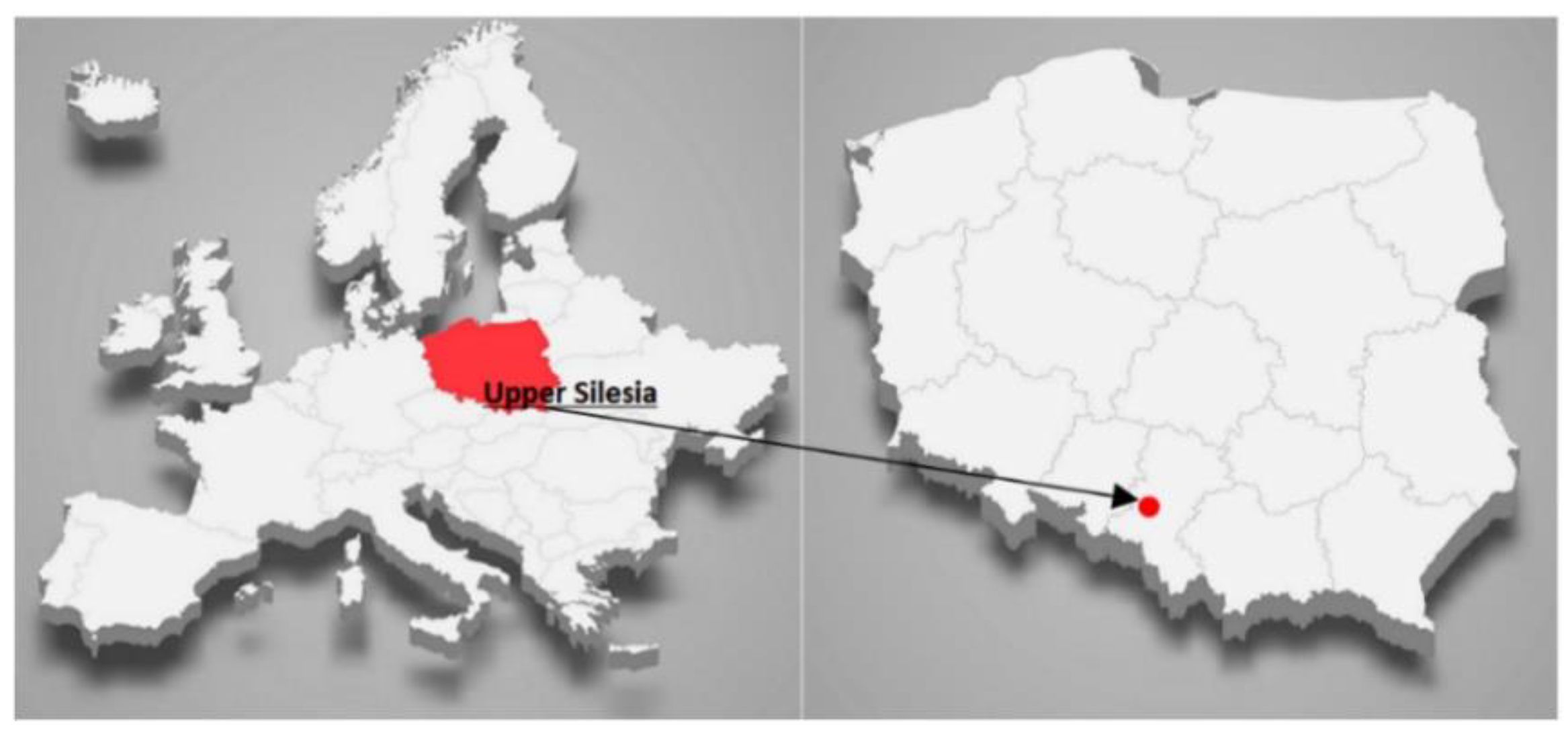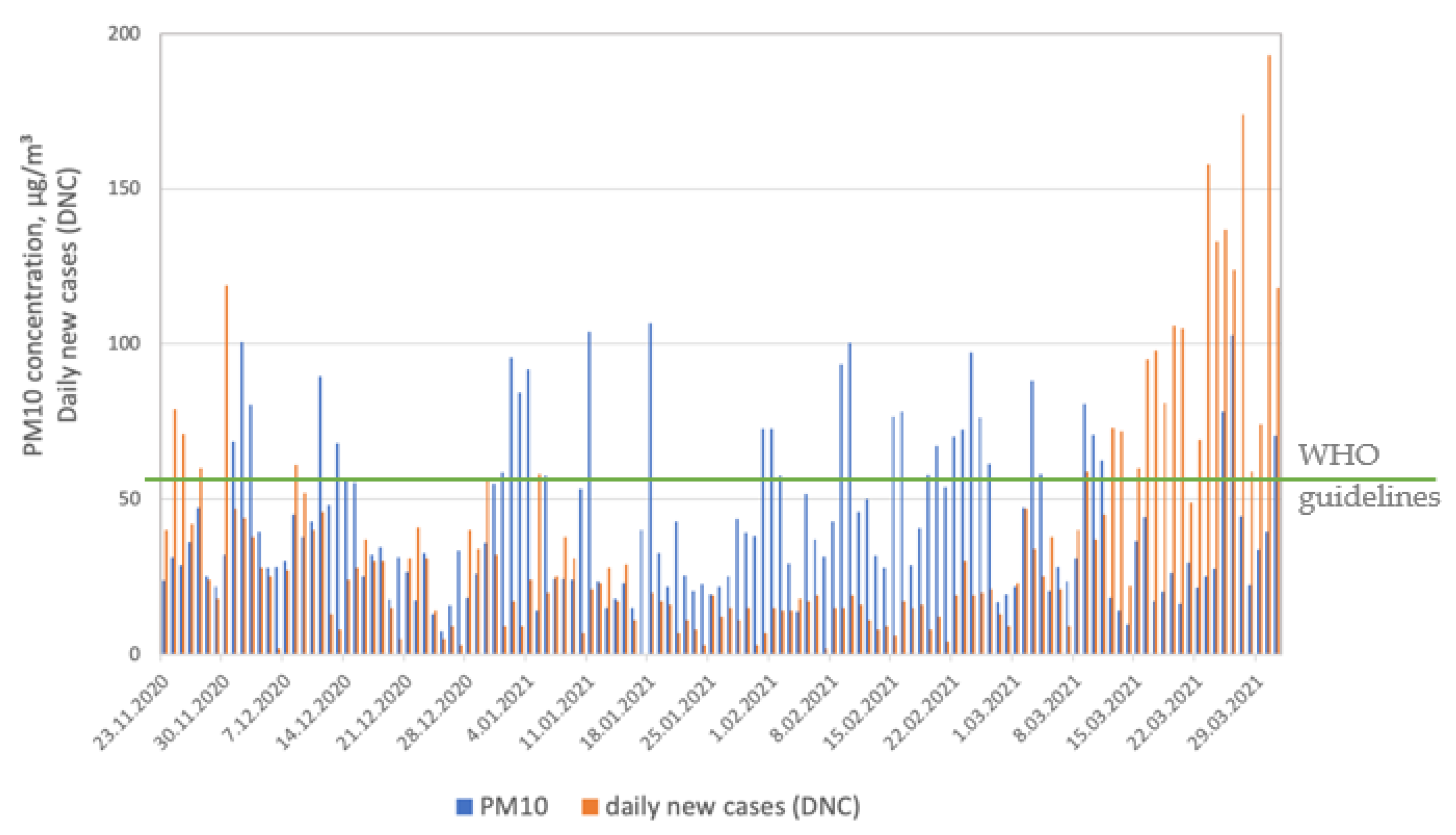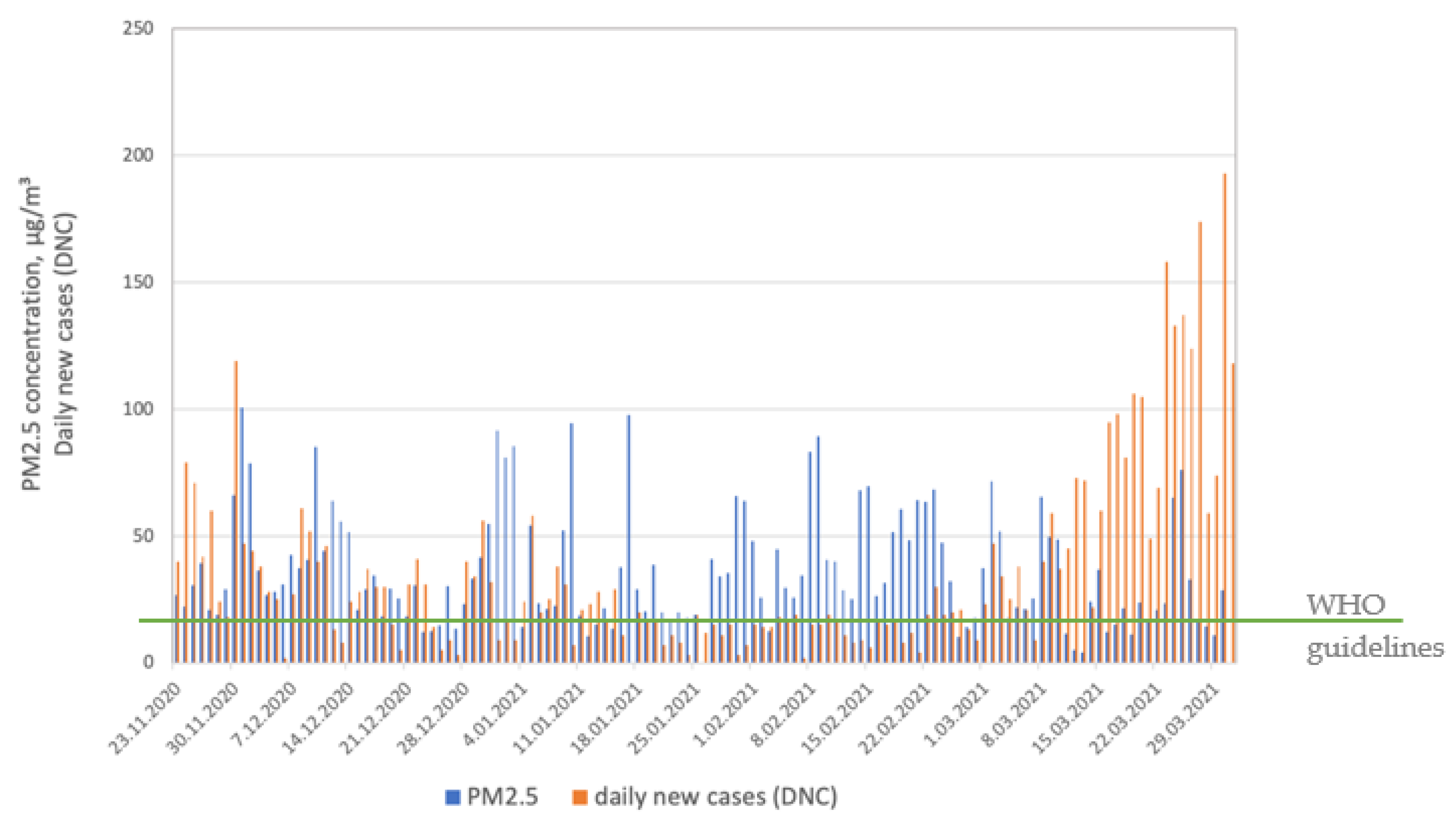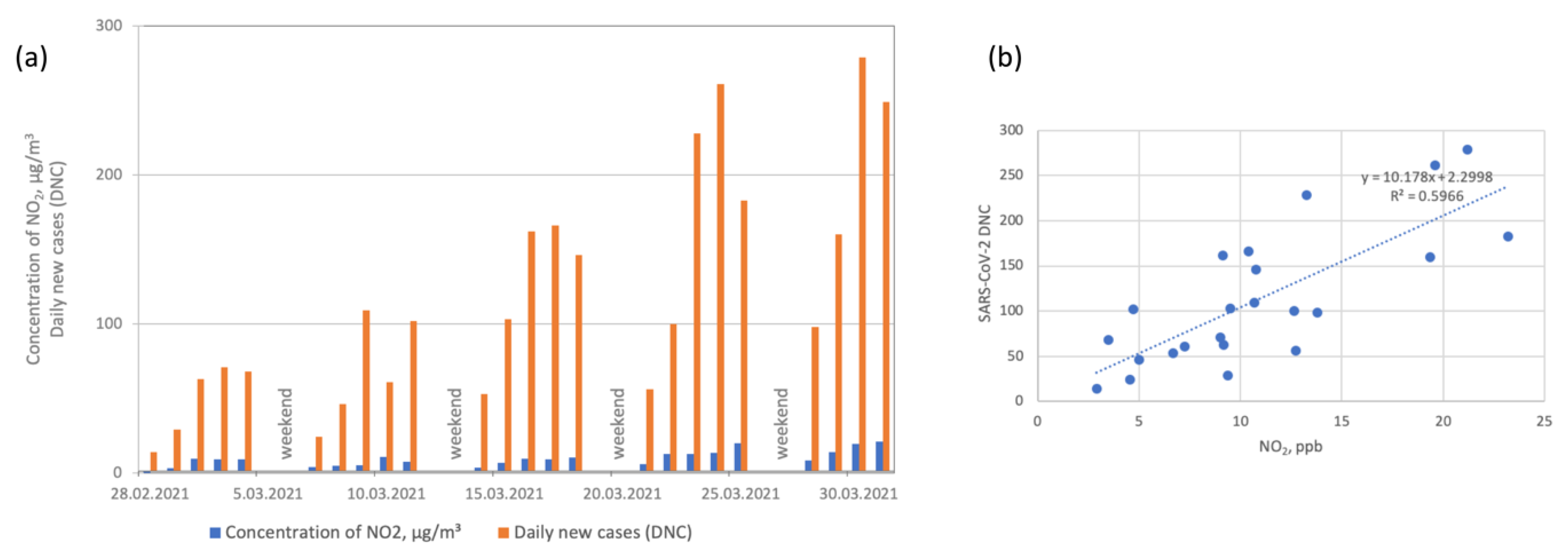Impact of Different Air Pollutants (PM10, PM2.5, NO2, and Bacterial Aerosols) on COVID-19 Cases in Gliwice, Southern Poland
Abstract
:1. Introduction
2. Materials and Methods
2.1. Sampling Sites
2.2. Measurements of Ambient Air Pollutants
2.3. Measurements of SARS-CoV-2 Cases
2.4. Statistical Analyses
3. Results and Discussion
3.1. Particulate Matter (PM) Concentrations and SARS-CoV-2 Daily New Cases (DNCs)
3.2. Meteorological Conditions and SARS-CoV-2 Daily New Cases (DNCs)
3.3. Bacterial Aerosol (BA) Concentrations and SARS-CoV-2 Daily New Cases (DNCs)
3.4. Nitrogen Dioxide (NO2) Concentrations and SARS-CoV-2 Daily New Cases (DNCs)
4. Conclusions
Author Contributions
Funding
Institutional Review Board Statement
Informed Consent Statement
Data Availability Statement
Conflicts of Interest
References
- Zumla, A.; Niederman, M.S. Editorial: The Explosive Epidemic Outbreak of Novel Coronavirus Disease 2019 (COVID-19) and the Persistent Threat of Respiratory Tract Infectious Diseases to Global Health Security. Curr. Opin. Pulm. Med. 2020, 26, 193–196. [Google Scholar] [CrossRef] [PubMed] [Green Version]
- WHO. Organization Mundial de la Salud (OMS). WHO|Coronavirus Disease (COVID-19) Pandemic-Emergency Use Listing Procedure (EUL) Open for in Vitro Diagnostics. 2020. Available online: https://extranet.who.int/pqweb/vitro-diagnostics/coronavirus-disease-covid-19-pandemic-%E2%80%94-emergency-use-listing-procedure-eul-open (accessed on 20 September 2022).
- Gujski, M.; Raciborski, F.; Jankowski, M.; Nowicka, P.M.; Rakocy, K.; Pinkas, J. Epidemiological Analysis of the First 1389 Cases of COVID-19 in Poland: A Preliminary Report. Med. Sci. Monit. 2020, 26, e924702. [Google Scholar] [CrossRef] [PubMed]
- Semczuk-Kaczmarek, K.; Rys-Czaporowska, A.; Sierdzinski, J.; Kaczmarek, L.D.; Szymanski, F.M.; Platek, A.E. Association between Air Pollution and COVID-19 Mortality and Morbidity. Intern. Emerg. Med. 2021, 17, 467–473. [Google Scholar] [CrossRef] [PubMed]
- Pikala, M.; Maniecka-Bryła, I. Fifteen-Year Mortality Trends in Poland Analysed with the Use of Standard Expected Years of Life Lost, 2000–2014. Sci. Rep. 2017, 7, 8730. [Google Scholar] [CrossRef] [PubMed] [Green Version]
- Tacconelli, E.; Carrara, E.; Savoldi, A.; Harbarth, S.; Mendelson, M.; Monnet, D.L.; Pulcini, C.; Kahlmeter, G.; Kluytmans, J.; Carmeli, Y.; et al. Discovery, Research, and Development of New Antibiotics: The WHO Priority List of Antibiotic-Resistant Bacteria and Tuberculosis. Lancet Infect. Dis. 2018, 18, 318–327. [Google Scholar] [CrossRef]
- Comunian, S.; Dongo, D.; Milani, C.; Palestini, P. Air Pollution and Covid-19: The Role of Particulate Matter in the Spread and Increase of Covid-19’s Morbidity and Mortality. Int. J. Environ. Res. Public Health 2020, 17, 4487. [Google Scholar] [CrossRef]
- Urrutia-Pereira, M.; Mello-da-Silva, C.A.; Solé, D. COVID-19 and Air Pollution: A Dangerous Association? Allergol. Immunopathol. 2020, 48, 496–499. [Google Scholar] [CrossRef]
- Albano, G.D.; Montalbano, A.M.; Gagliardo, R.; Anzalone, G.; Profita, M. Impact of Air Pollution in Airway Diseases: Role of the Epithelial Cells (Cell Models and Biomarkers). Int. J. Mol. Sci. 2022, 23, 2799. [Google Scholar] [CrossRef]
- van der Valk, J.P.M.; In’t Veen, J.C.C.M. The Interplay Between Air Pollution and Coronavirus Disease (COVID-19). J. Occup. Environ. Med. 2021, 63, e163–e167. [Google Scholar] [CrossRef]
- Ciencewicki, J.; Jaspers, I. Air Pollution and Respiratory Viral Infection. Inhal. Toxicol. 2007, 19, 1135–1146. [Google Scholar] [CrossRef]
- Huff, R.D.; Carlsten, C.; Hirota, J.A. An Update on Immunologic Mechanisms in the Respiratory Mucosa in Response to Air Pollutants. J. Allergy Clin. Immunol. 2019, 143, 1989–2001. [Google Scholar] [CrossRef] [PubMed]
- Conticini, E.; Frediani, B.; Caro, D. Can Atmospheric Pollution Be Considered a Co-Factor in Extremely High Level of SARS-CoV-2 Lethality in Northern Italy? Environ. Pollut. 2020, 261, 114465. [Google Scholar] [CrossRef] [PubMed]
- Wu, X.; Nethery, R.C.; Sabath, M.B.; Braun, D.; Dominici, F. Exposure to Air Pollution and COVID-19 Mortality in the United States: A Nationwide Cross-Sectional Study. Sci. Adv. 2020, 6, 1–6. [Google Scholar] [CrossRef] [PubMed]
- Setti, L.; Passarini, F.; De Gennaro, G.; Barbieri, P.; Perrone, M.G.; Borelli, M.; Palmisani, J.; Di Gilio, A.; Torboli, V.; Fontana, F.; et al. SARS-CoV-2RNA Found on Particulate Matter of Bergamo in Northern Italy: First Evidence. Environ. Res. 2020, 188, 109754. [Google Scholar] [CrossRef] [PubMed]
- Jiang, Y.; Xu, J. The Association between COVID-19 Deaths and Short-Term Ambient Air Pollution/Meteorological Condition Exposure: A Retrospective Study from Wuhan, China. Air Qual. Atmos. Health 2021, 14, 1–5. [Google Scholar] [CrossRef] [PubMed]
- Yao, Y.; Pan, J.; Liu, Z.; Meng, X.; Wang, W.; Kan, H.; Wang, W. Ambient Nitrogen Dioxide Pollution and Spreadability of COVID-19 in Chinese Cities. Ecotoxicol. Environ. Saf. 2021, 208, 111421. [Google Scholar] [CrossRef]
- Travaglio, M.; Yu, Y.; Popovic, R.; Selley, L.; Leal, N.S.; Martins, L.M. Links between Air Pollution and COVID-19 in England. Environ. Pollut. 2021, 268, 115859. [Google Scholar] [CrossRef]
- Accarino, G.; Lorenzetti, S.; Aloisio, G. Assessing Correlations between Short-Term Exposure to Atmospheric Pollutants and COVID-19 Spread in All Italian Territorial Areas. Environ. Pollut. 2021, 268, 115714. [Google Scholar] [CrossRef]
- Bochenek, B.; Jankowski, M.; Gruszczynska, M.; Nykiel, G.; Gruszczynski, M.; Jaczewski, A.; Ziemianski, M.; Pyrc, R.; Figurski, M.; Pinkas, J. Impact of Meteorological Conditions on the Dynamics of the COVID-19 Pandemic in Poland. Int. J. Environ. Res. Public Health 2021, 18, 3951. [Google Scholar] [CrossRef]
- Rendana, M.; Idris, W.M.R. New COVID-19 Variant (B.1.1.7): Forecasting the Occasion of Virus and the Related Meteorological Factors. J. Infect. Public Health 2021, 14, 1320–1327. [Google Scholar] [CrossRef]
- Sarmadi, M.; Rahimi, S.; Evensen, D.; Kazemi Moghaddam, V. Interaction between Meteorological Parameters and COVID-19: An Ecological Study on 406 Authorities of the UK. Environ. Sci. Pollut. Res. 2021, 28, 67082–67097. [Google Scholar] [CrossRef] [PubMed]
- Rendana, M. Impact of the Wind Conditions on COVID-19 Pandemic: A New Insight for Direction of the Spread of the Virus. Urban. Clim 2020, 34, 100680. [Google Scholar] [CrossRef] [PubMed]
- Mao, N.; Zhang, D.; Li, Y.; Li, Y.; Li, J.; Zhao, L.; Wang, Q.; Cheng, Z.; Zhang, Y.; Long, E. How Do Temperature, Humidity, and Air Saturation State Affect the COVID-19 Transmission Risk? Environ. Sci. Pollut. Res. Int. 2022. online ahead of print. [Google Scholar] [CrossRef] [PubMed]
- Haas, D.; Unteregger, M.; Habib, J.; Galler, H.; Marth, E.; Reinthaler, F.F. Exposure to Bioaerosol from Sewage Systems. Water Air Soil Pollut. 2010, 207, 49–56. [Google Scholar] [CrossRef]
- Brągoszewska, E.; Pastuszka, J.S. Influence of Meteorological Factors on the Level and Characteristics of Culturable Bacteria in the Air in Gliwice, Upper Silesia (Poland). Aerobiologia 2018, 34, 241–255. [Google Scholar] [CrossRef] [PubMed] [Green Version]
- Woo, A.C.; Brar, M.S.; Chan, Y.; Lau, M.C.Y.; Leung, F.C.C.; Scott, J.A.; Vrijmoed, L.L.P.; Zawar-Reza, P.; Pointing, S.B. Temporal Variation in Airborne Microbial Populations and Microbially-Derived Allergens in a Tropical Urban Landscape. Atmos. Environ. 2013, 74, 291–300. [Google Scholar] [CrossRef]
- Ruiz-Gil, T.; Acuña, J.J.; Fujiyoshi, S.; Tanaka, D.; Noda, J.; Maruyama, F.; Jorquera, M.A. Airborne Bacterial Communities of Outdoor Environments and Their Associated Influencing Factors. Environ. Int. 2020, 145, 106156. [Google Scholar] [CrossRef]
- Šantl-Temkiv, T.; Gosewinkel, U.; Starnawski, P.; Lever, M.; Finster, K. Aeolian Dispersal of Bacteria in Southwest Greenland: Their Sources, Abundance, Diversity and Physiological States. FEMS Microbiol. Ecol. 2018, 94, fiy031. [Google Scholar] [CrossRef] [Green Version]
- Chegini, F.M.; Baghani, A.N.; Hassanvand, M.S.; Sorooshian, A.; Golbaz, S.; Bakhtiari, R.; Ashouri, A.; Joubani, M.N.; Alimohammadi, M. Indoor and Outdoor Airborne Bacterial and Fungal Air Quality in Kindergartens: Seasonal Distribution, Genera, Levels, and Factors Influencing Their Concentration. Build. Environ. 2020, 175, 106690. [Google Scholar] [CrossRef]
- Brągoszewska, E.; Biedroń, I. Efficiency of Air Purifiers at Removing Air Pollutants in Educational Facilities: A Preliminary Study. Front. Environ. Sci. 2021, 9, 370. [Google Scholar] [CrossRef]
- Dabrowiecki, P.; Adamkiewicz, Ł.; Mucha, D.; Czechowski, P.O.; Soliński, M.; Chciałowski, A.; Badyda, A. Impact of Air Pollution on Lung Function among Preadolescent Children in Two Cities in Poland. J. Clin. Med. 2021, 10, 2375. [Google Scholar] [CrossRef] [PubMed]
- GIOS. Chief Inspectorate for Environmental Protection. Available online: https://www.cleanenergywire.org/experts/chief-inspectorate-environmental-protection-gios-poland (accessed on 15 September 2022).
- Brągoszewska, E.; Mainka, A.; Pastuszka, J. Bacterial and Fungal Aerosols in Rural Nursery Schools in Southern Poland. Atmosphere 2016, 7, 142. [Google Scholar] [CrossRef] [Green Version]
- Brągoszewska, E.; Biedroń, I. Indoor Air Quality and Potential Health Risk Impacts of Exposure to Antibiotic Resistant Bacteria in an Office Rooms in Southern Poland. Int. J. Environ. Res. Public Health 2018, 15, 2604. [Google Scholar] [CrossRef] [Green Version]
- Government of Poland Report of Coronavirus Infection (SARS-CoV-2)-Coronavirus: Information and Recommendations—Portal Gov.Pl. Available online: https://www.gov.pl/web/koronawirus/wykaz-zarazen-koronawirusem-sars-cov-2 (accessed on 28 October 2021).
- Khan, Z.; Ualiyeva, D.; Khan, A.; Zaman, N.; Sapkota, S.; Khan, A.; Ali, B.; Ghafoor, D. A Correlation among the COVID-19 Spread, Particulate Matters, and Angiotensin-Converting Enzyme 2: A Review. J. Environ. Public Health 2021, 2021, 1–8. [Google Scholar] [CrossRef]
- Seposo, X.; Ueda, K.; Sugata, S.; Yoshino, A.; Takami, A. Short-Term Effects of Air Pollution on Daily Single- and Co-Morbidity Cardiorespiratory Outpatient Visits. Sci. Total Environ. 2020, 729, 138934. [Google Scholar] [CrossRef] [PubMed]
- Kelly, F.J.; Fussell, J.C. Air Pollution and Airway Disease. Clin. Exp. Allergy 2011, 41, 1059–1071. [Google Scholar] [CrossRef] [PubMed]
- Contini, D.; Costabile, F. Does Air Pollution Influence COVID-19 Outbreaks? Atmosphere 2020, 11, 377. [Google Scholar] [CrossRef] [Green Version]
- Pansini, R.; Fornacca, D. Early Spread of COVID-19 in the Air-Polluted Regions of Eight Severely Affected Countries. Atmosphere 2021, 12, 795. [Google Scholar] [CrossRef]
- Meo, S.A.; Almutairi, F.J.; Abukhalaf, A.A.; Alessa, O.M.; Al-Khlaiwi, T.; Meo, A.S. Sandstorm and Its Effect on Particulate Matter PM2.5, Carbon Monoxide, Nitrogen Dioxide, Ozone Pollutants and SARS-CoV-2 Cases and Deaths. Sci. Total Environ. 2021, 795, 148764. [Google Scholar] [CrossRef]
- Nidzgorska-Lencewicz, J.; Czarnecka, M. Thermal Inversion and Particulate Matter Concentration in Wrocław in Winter Season. Atmosphere 2020, 11, 1351. [Google Scholar] [CrossRef]
- Zajusz-Zubek, E.; Filipek, J.; Mainka, A. The Impact of Sources Burning Solid Fuels on Environmental Pollution with PM10 on the Example of the City Tarnowskie Góry. Eng. Prot. Environ. 2019, 22, 15–26. [Google Scholar] [CrossRef]
- World Health Organization. WHO Global Air Quality Guidelines. Particulate Matter (PM2.5 and PM10), Ozone, Nitrogen Dioxide, Sulfur Dioxide and Carbon Monoxide; WHO: Geneva, Switzerland, 2021. [Google Scholar]
- Farrell, J.M.; Zhao, C.Y.; Tarquinio, K.M.; Brown, S.P. Causes and Consequences of COVID-19-Associated Bacterial Infections. Front. Microbiol. 2021, 12, 1–6. [Google Scholar] [CrossRef] [PubMed]
- Hemati, S.; Mobini, G.R.; Heidari, M.; Rahmani, F.; Soleymani Babadi, A.; Farhadkhani, M.; Nourmoradi, H.; Raeisi, A.; Ahmadi, A.; Khodabakhshi, A.; et al. Simultaneous Monitoring of SARS-CoV-2, Bacteria, and Fungi in Indoor Air of Hospital: A Study on Hajar Hospital in Shahrekord, Iran. Environ. Sci. Pollut. Res. 2021, 28, 43792–43802. [Google Scholar] [CrossRef] [PubMed]
- Zhou, F.; Yu, T.; Du, R.; Fan, G.; Liu, Y.; Liu, Z.; Xiang, J.; Wang, Y.; Song, B.; Gu, X.; et al. Clinical Course and Risk Factors for Mortality of Adult Inpatients with COVID-19 in Wuhan, China: A Retrospective Cohort Study. Lancet 2020, 395, 1054–1062. [Google Scholar] [CrossRef]
- Ravindra, K.; Goyal, A.; Mor, S. Does Airborne Pollen Influence COVID-19 Outbreak? Sustain. Cities Soc. 2021, 70, 02887. [Google Scholar] [CrossRef]
- Shammi, M.; Rahman, M.M.; Tareq, S.M. Distribution of Bioaerosols in Association With Particulate Matter: A Review on Emerging Public Health Threat in Asian Megacities. Front. Environ. Sci. 2021, 9, 328. [Google Scholar] [CrossRef]
- Mentese, S.; Arisoy, M.; Rad, A.Y.; Güllü, G. Bacteria and Fungi Levels in Various Indoor and Outdoor Environments in Ankara, Turkey. Clean 2009, 37, 487–493. [Google Scholar] [CrossRef]
- Aydogdu, H.; Asan, A.; Tatman Otkun, M. Indoor and outdoor airborne bacteria in child day-care centers in Edirne City (Turkey), seasonal distribution and influence of meteorological factors. Environ. Monit. Assess. 2009, 164, 53–66. [Google Scholar] [CrossRef]
- Bartlett, K.H.; Kennedy, S.M.; Brauer, M.; van Netten, C.; Dill, B. Evaluation and Determinants of Airborne Bacterial Concentrations in School Classrooms. J. Occup. Environ. Hyg. 2004, 1, 639–647. [Google Scholar] [CrossRef]
- Fang, Z.; Ouyang, Z.; Zheng, H.; Wang, X.; Hu, L. Culturable Airborne Bacteria in Outdoor Environments in Beijing, China. Microb. Ecol. 2007, 54, 487–496. [Google Scholar] [CrossRef]
- Ali, N.; Islam, F. The Effects of Air Pollution on COVID-19 Infection and Mortality—A Review on Recent Evidence. Front. Public Health 2020, 8, 580057. [Google Scholar] [CrossRef] [PubMed]
- Li, H.; Xu, X.L.; Dai, D.W.; Huang, Z.Y.; Ma, Z.; Guan, Y.J. Air Pollution and Temperature Are Associated with Increased COVID-19 Incidence: A Time Series Study. Int. J. Infect. Dis. 2020, 97, 278–282. [Google Scholar] [CrossRef] [PubMed]
- Ogen, Y. Response to the Commentary by Alexandra A. Chudnovsky on ‘Assessing Nitrogen Dioxide (NO2) Levels as a Contributing Factor to Coronavirus (COVID-19) Fatality’. Sci. Total Environ. 2020, 740, 138605. [Google Scholar] [CrossRef] [PubMed]







| Parameters | Mean | Median | SD | Min | Max | Lilliefors Test | W | Shapiro–Wilk Test |
|---|---|---|---|---|---|---|---|---|
| SARS-CoV-2 cases | 112 | 100 | 74 | 14 | 279 | p < 0.1 | 0.92 | 0.07 |
| BAs, CFU/m3 | 703 | 690 | 161 | 410 | 980 | p > 0.2 | 0.97 | 0.73 |
| PM2.5 1, μg/m3 | 33.1 | 24.2 | 20.9 | 10.9 | 76.1 | p < 0.01 | 0.87 | 0.01 |
| PM10 1, μg/m3 | 45.3 | 36.6 | 25.8 | 17.2 | 102.9 | p < 0.15 | 0.89 | 0.02 |
| PM10 2, μg/m3 | 38.9 | 28.1 | 26.5 | 11.4 | 106.0 | p < 0.01 | 0.85 | 0.01 |
| SO2, ppb | 3.0 | 2.2 | 2.4 | 0.5 | 9.1 | p < 0.01 | 0.79 | <0.01 |
| NO, ppb | 5.0 | 4.3 | 3.6 | 1.5 | 15.5 | p < 0.05 | 0.85 | <0.01 |
| NO2, ppb | 10.8 | 9.5 | 5.6 | 2.9 | 23.2 | p < 0.15 | 0.93 | 0.09 |
| NOx, ppb | 14.8 | 14.3 | 7.9 | 5.0 | 35.1 | p < 0.2 | 0.91 | 0.05 |
| O3, ppb | 22.5 | 23.6 | 5.9 | 5.5 | 31.4 | p > 0.2 | 0.94 | 0.15 |
| CO, ppm | 0.4 | 0.3 | 0.2 | 0.2 | 0.9 | p < 0.05 | 0.86 | <0.01 |
| t, °C | 4.4 | 3.4 | 3.9 | −0.3 | 13.3 | p < 0.15 | 0.91 | 0.03 |
| RH, % | 73.3 | 71.5 | 6.9 | 61.5 | 88.8 | p > 0.2 | 0.97 | 0.58 |
| P, hPa | 996.9 | 995.6 | 7.4 | 985.9 | 1013.4 | p < 0.1 | 0.94 | 0.17 |
| Wind speed, m/s | 1.5 | 1.3 | 0.7 | 0.5 | 2.8 | p > 0.2 | 0.95 | 0.34 |
| Wind direction, ° | 185.8 | 195.4 | 69.4 | 17.8 | 324.5 | p < 0.05 | 0.94 | 0.19 |
| Parameters | DNCs | BAs | PM2.5 1 | PM10 1 | PM10 2 | SO2 | NO | NO2 | NOx | O3 | CO |
|---|---|---|---|---|---|---|---|---|---|---|---|
| DNCs | 1 | 0.903 | −0.060 | 0.062 | −0.205 | 0.377 | 0.477 | 0.724 | 0.595 | −0.325 | 0.266 |
| BA CFU/m3 | 1 | −0.014 | <0.01 | −0.237 | 0.384 | 0.319 | 0.632 | 0.479 | −0.247 | 0.207 | |
| PM2.5 1 μg/m3 | 1 | 0.869 | 0.891 | 0.513 | 0.086 | 0.072 | −0.007 | −0.344 | 0.614 | ||
| PM10 1 μg/m3 | 1 | 0.868 | 0.708 | 0.329 | 0.320 | 0.245 | −0.491 | 0.828 | |||
| PM10 2 μg/m3 | 1 | 0.527 | −0.244 | −0.005 | −0.324 | −0.226 | 0.602 | ||||
| SO2 | 1 | 0.460 | 0.622 | 0.556 | −0.517 | 0.776 | |||||
| NO | 1 | 0.853 | 0.925 | −0.809 | 0.506 | ||||||
| NO2 | 1 | 0.970 | −0.607 | 0.521 | |||||||
| NOx | 1 | −0.681 | 0.465 | ||||||||
| O3 | 1 | −0.637 |
| Parameters | DNCs | BAs | Temperature | RH | Atmospheric Pressure | Wind Speed | Wind Direction |
|---|---|---|---|---|---|---|---|
| Temperature | 0.387 | 0.251 | 1 | −0.309 | 0.278 | −0.089 | −0.024 |
| RH | −0.377 | −0.386 | −0.309 | 1 | 0.007 | 0.194 | 0.409 |
| Atmospheric pressure | −0.148 | −0.426 | 0.278 | 0.007 | 1 | −0.367 | −0.010 |
| Wind speed | 0.016 | 0.041 | −0.089 | 0.194 | −0.367 | 1 | 0.005 |
| Wind direction | −0.477 | −0.288 | 0.024 | 0.409 | −0.010 | 0.005 | 1 |
| Species of Isolated Bacteria |
|---|
| Bacillus cereus |
| Bacillus subtilis |
| Bacillus flexus |
| Bacillus licheniformis Paenibacillus barengoltzii |
| Micrococcus luteus |
| Macrococcus equipercicus |
| Macrococcus brunensis |
| Nocardia alba |
| Lactobacillus crispatus |
Publisher’s Note: MDPI stays neutral with regard to jurisdictional claims in published maps and institutional affiliations. |
© 2022 by the authors. Licensee MDPI, Basel, Switzerland. This article is an open access article distributed under the terms and conditions of the Creative Commons Attribution (CC BY) license (https://creativecommons.org/licenses/by/4.0/).
Share and Cite
Brągoszewska, E.; Mainka, A. Impact of Different Air Pollutants (PM10, PM2.5, NO2, and Bacterial Aerosols) on COVID-19 Cases in Gliwice, Southern Poland. Int. J. Environ. Res. Public Health 2022, 19, 14181. https://doi.org/10.3390/ijerph192114181
Brągoszewska E, Mainka A. Impact of Different Air Pollutants (PM10, PM2.5, NO2, and Bacterial Aerosols) on COVID-19 Cases in Gliwice, Southern Poland. International Journal of Environmental Research and Public Health. 2022; 19(21):14181. https://doi.org/10.3390/ijerph192114181
Chicago/Turabian StyleBrągoszewska, Ewa, and Anna Mainka. 2022. "Impact of Different Air Pollutants (PM10, PM2.5, NO2, and Bacterial Aerosols) on COVID-19 Cases in Gliwice, Southern Poland" International Journal of Environmental Research and Public Health 19, no. 21: 14181. https://doi.org/10.3390/ijerph192114181
APA StyleBrągoszewska, E., & Mainka, A. (2022). Impact of Different Air Pollutants (PM10, PM2.5, NO2, and Bacterial Aerosols) on COVID-19 Cases in Gliwice, Southern Poland. International Journal of Environmental Research and Public Health, 19(21), 14181. https://doi.org/10.3390/ijerph192114181







